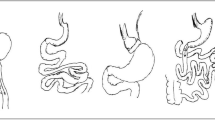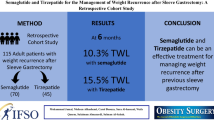Abstract
Background
Non-alcoholic fatty liver disease (NAFLD) affects 75 to 100% of the patients undergoing bariatric surgery (BSx), with non-alcoholic steatohepatitis (NASH) being present in 24 to 98% of the patients. We do not know whether these rates were before or after a very low calorie diet (VLCD) often prescribed before laparoscopic BSx and what is the prevalence of NAFLD post-VLCD.
Purpose
The purpose of this study is to determine the prevalence of simple steatosis (SS) and NASH in obese individuals undergoing BSx post-VLCD and assess biochemical markers pre- and post-VLCD in a subgroup of patients.
Methods
One hundred and thirty-nine patients undergoing BSx at a single Canadian bariatric program had biochemical and clinical variables collected pre-VLCD. In 21 patients, biochemical measurements were repeated post-VLCD. During BSx, a wedged liver biopsy was performed in all patients and histology was reported as normal liver (NL), SS, or NASH.
Results
NAFLD was diagnosed in 76.3% of the BSx patients with 61.9% having SS and 14.4% having NASH; 23.7% had NL. Those with NASH had significantly higher (p < 0.05) pre-VLCD ALT, AST, insulin resistance, and proportion of individuals with diabetes compared to those with NL. Overall, VLCD resulted in significant decreases in BMI, ALP, fasting glucose and insulin, HbA1c, total cholesterol, HDL and LDL cholesterol, and significant increases in AST and ALT. Changes were similar between groups.
Conclusions
Post-VLCD, the prevalence of NAFLD and NASH was lower compared to published reports, with almost 25% of the patients having a NL. With VLCD, metabolic and clinical changes were similar between the three groups suggesting that pre-VLCD factors may affect liver histology.

Similar content being viewed by others
References
Obesity in Canada: a whole-of-society approach for healthier Canada. Senate. Standing Committee on Social Affairs SaT; 2016.
Table 105-0501 - Health indicator profile, annual estimates, by age group and sex, Canada, provinces, territories, health regions (2013 boundaries) and peer groups, occasional. Statistics Canada; 2013.
Courcoulas AP, Christian NJ, Belle SH, et al. Weight change and health outcomes at 3 years after bariatric surgery among individuals with severe obesity. JAMA. 2013;310(22):2416–25.
Mostaedi R, Lackey DE, Adams SH, et al. Prevalence of undiagnosed and inadequately treated type 2 diabetes mellitus, hypertension, and dyslipidemia in morbidly obese patients who present for bariatric surgery. Obes Surg. 2014;24(6):927–35.
Sjostrom L, Peltonen M, Jacobson P, et al. Association of bariatric surgery with long-term remission of type 2 diabetes and with microvascular and macrovascular complications. JAMA. 2014 Jun 11;311(22):2297–304.
Hewitt S, Humerfelt S, Sovik TT, et al. Long-term improvements in pulmonary function 5 years after bariatric surgery. Obes Surg. 2014;24(5):705–11.
Mummadi RR, Kasturi KS, Chennareddygari S, et al. Effect of bariatric surgery on nonalcoholic fatty liver disease: systematic review and meta-analysis. Clin Gastroenterol Hepatol. 2008;6(12):1396–402.
Colquitt JL, Picot J, Loveman E, et al. Surgery for obesity. Cochrane Database Syst Rev. 2009;15(2):CD003641.
Charrez B, Qiao L, Hebbard L. Hepatocellular carcinoma and non-alcoholic steatohepatitis: the state of play. World J Gastroenterol. 2016;22(8):2494–502.
Clark JM, Diehl AM. Hepatic steatosis and type 2 diabetes mellitus. Curr Diab Rep. 2002;2(3):210–5.
Bedogni G, Miglioli L, Masutti F, et al. Prevalence of and risk factors for nonalcoholic fatty liver disease: the Dionysos nutrition and liver study. Hepatology. 2005;42(1):44–52.
Browning JD, Szczepaniak LS, Dobbins R, et al. Prevalence of hepatic steatosis in an urban population in the United States: impact of ethnicity. Hepatology. 2004;40(6):1387–95.
Vernon G, Baranova A, Younossi ZM. Systematic review: the epidemiology and natural history of non-alcoholic fatty liver disease and non-alcoholic steatohepatitis in adults. Aliment Pharmacol Ther. 2011;34(3):274–85.
Machado M, Marques-Vidal P, Cortez-Pinto H. Hepatic histology in obese patients undergoing bariatric surgery. J Hepatol. 2006;45(4):600–6.
Sjostrom L, Narbro K, Sjostrom CD, et al. Effects of bariatric surgery on mortality in Swedish obese subjects. N Engl J Med. 2007;357(8):741–52.
Moschen AR, Molnar C, Wolf AM, et al. Effects of weight loss induced by bariatric surgery on hepatic adipocytokine expression. J Hepatol. 2009;51(4):765–77.
Fris RJ. Preoperative low energy diet diminishes liver size. Obes Surg. 2004;14(9):1165–70.
Doyle A, Adeyi O, Khalili K, et al. Treatment with Optifast reduces hepatic steatosis and increases candidacy rates for living donor liver transplantation. Liver Transpl. 2016;22(9):1295–300.
Gastrointestinal surgery for severe obesity. Consensus statement / NIH Consensus Development Conference National Institutes of Health Consensus Development Conference. 1991 Mar 25-27;9(1):1-20.
Bastow MD. Anthropometrics revisited. Proc Nutr Soc. 1982;41(3):381–8.
Matthews DR, Hosker JP, Rudenski AS, et al. Homeostasis model assessment: insulin resistance and beta-cell function from fasting plasma glucose and insulin concentrations in man. Diabetologia. 1985;28(7):412–9.
Brunt EM, Janney CG, Di Bisceglie AM, et al. Nonalcoholic steatohepatitis: a proposal for grading and staging the histological lesions. Am J Gastroenterol. 1999;94(9):2467–74.
Alberti KG, Eckel RH, Grundy SM, et al. Harmonizing the metabolic syndrome: a joint interim statement of the international diabetes federation task force on epidemiology and prevention; National Heart, Lung, and Blood Institute; American Heart Association; World Heart Federation; International Atherosclerosis Society; and International Association for the Study of Obesity. Circulation. 2009;120(16):1640–5.
Saleh F, Doumouras AG, Gmora S, et al. Outcomes of the Ontario Bariatric Network: a cohort study. CMAJ Open. 2016;4(3):E383–E9.
Canadian Institute for Health Information. Bariatric surgery in Canada. Bariatric Surgery in Canada. Ottawa, ON: CIHI; 2014.
Clark JM. The epidemiology of nonalcoholic fatty liver disease in adults. J Clin Gastroenterol. 2006;40(Suppl 1):S5–10.
Busetto L, Tregnaghi A, De Marchi F, et al. Liver volume and visceral obesity in women with hepatic steatosis undergoing gastric banding. Obes Res. 2002;10(5):408–11.
Nguyen NT, Longoria M, Gelfand DV, et al. Staged laparoscopic Roux-en-Y: a novel two-stage bariatric operation as an alternative in the super-obese with massively enlarged liver. Obes Surg. 2005;15(7):1077–81.
Lewis MC, Phillips ML, Slavotinek JP, et al. Change in liver size and fat content after treatment with Optifast® very low calorie diet. Obes Surg. 2006;16(6):697–701.
Frith J, Day CP, Henderson E, et al. Non-alcoholic fatty liver disease in older people. Gerontology. 2009;55(6):607–13.
Kelley DE, McKolanis TM, Hegazi RA, et al. Fatty liver in type 2 diabetes mellitus: relation to regional adiposity, fatty acids, and insulin resistance. Am J Physiol Endocrinol Metab. 2003;285(4):E906–16.
Luyckx FH, Lefebvre PJ, Scheen AJ. Non-alcoholic steatohepatitis: association with obesity and insulin resistance, and influence of weight loss. Diabetes Metab. 2000;26(2):98–106.
Adams LA, Feldstein AE. Non-invasive diagnosis of nonalcoholic fatty liver and nonalcoholic steatohepatitis. J Dig Dis. 2011;12(1):10–6.
Bugianesi E, Marchesini G, Gentilcore E, et al. Fibrosis in genotype 3 chronic hepatitis C and nonalcoholic fatty liver disease: role of insulin resistance and hepatic steatosis. Hepatology. 2006;44(6):1648–55.
Saponaro C, Gaggini M, Gastaldelli A. Nonalcoholic fatty liver disease and type 2 diabetes: common pathophysiologic mechanisms. Curr Diab Rep. 2015;15(6):607.
Liu KH, Chan YL, Chan JC, et al. Mesenteric fat thickness as an independent determinant of fatty liver. Int J Obes. 2006;30(5):787–93.
Kral JG, Schaffner F, Pierson Jr RN, et al. Body fat topography as an independent predictor of fatty liver. Metabolism. 1993;42(5):548–51.
Stefan N, Machicao F, Staiger H, et al. Polymorphisms in the gene encoding adiponectin receptor 1 are associated with insulin resistance and high liver fat. Diabetologia. 2005;48(11):2282–91.
Faith JJ, McNulty NP, Rey FE, et al. Predicting a human gut microbiota’s response to diet in gnotobiotic mice. Science. 2011;333(6038):101–4.
Wu GD, Chen J, Hoffmann C, et al. Linking long-term dietary patterns with gut microbial enterotypes. Science. 2011;334(6052):105–8.
Payne AN, Chassard C, Lacroix C. Gut microbial adaptation to dietary consumption of fructose, artificial sweeteners and sugar alcohols: implications for host-microbe interactions contributing to obesity. Obes Rev. 2012;13(9):799–809.
Moore WE, Moore LH. Intestinal floras of populations that have a high risk of colon cancer. Appl Environ Microbiol. 1995;61(9):3202–7.
Spencer MD, Hamp TJ, Reid RW, et al. Association between composition of the human gastrointestinal microbiome and development of fatty liver with choline deficiency. Gastroenterology. 2011;140(3):976–86.
Adams LA, Angulo P, Lindor KD. Nonalcoholic fatty liver disease. CMAJ : Canadian Medical Association journal = journal de l'Association medicale canadienne. 2005;172(7):899–905.
Wahlroos S, Phillips ML, Lewis MC, et al. Rapid significant weight loss and regional lipid deposition: implications for insulin sensitivity. Obes Res Clin Pract. 2007;1(1):1–78.
Gasteyger C, Larsen TM, Vercruysse F, et al. Effect of a dietary-induced weight loss on liver enzymes in obese subjects. Am J Clin Nutr. 2008;87(5):1141–7.
Hoy MK, Heshka S, Allison DB, et al. Reduced risk of liver-function-test abnormalities and new gallstone formation with weight loss on 3350-kJ (800-kcal) formula diets. Am J Clin Nutr. 1994;60(2):249–54.
Thoma C, Day CP, Trenell MI. Lifestyle interventions for the treatment of non-alcoholic fatty liver disease in adults: a systematic review. J Hepatol. 2012 Jan;56(1):255–66.
Andersen T, Gluud C, Franzmann MB, et al. Hepatic effects of dietary weight loss in morbidly obese subjects. J Hepatol. 1991;12(2):224–9.
Ghadir MR, Riahin AA, Havaspour A, et al. The relationship between lipid profile and severity of liver damage in cirrhotic patients. Hepat Mon. 2010;10(4):285–8.
Selimoglu MA, Aydogdu S, Yagci RV. Lipid parameters in childhood cirrhosis and chronic liver disease. Pediatr Int. 2002;44(4):400–3.
Acknowledgements
The authors are appreciative and acknowledge the important contributions made by the research assistants, clinical staff, surgical staff, bariatric clinic nurses, operating room nurses, and study participants at the University Health Network.
Funding
This study was funded by the Canadian Institutes for Health Research, Operating Grant MOP-126139.
Author information
Authors and Affiliations
Corresponding author
Ethics declarations
Conflict of Interest
Authors 1–3 and 5 have no conflict of interest to declare. Author 4 has relevant financial activities outside of the submitted work. He is provided an honorarium for speaking and teaching from Ethicon and Medtronic.
Ethical Approval
All procedures performed in studies involving human participants were in accordance with the ethical standards of the institutional and/or national research committee and with the 1964 Helsinki Declaration and its later amendments or comparable ethical standards.
Informed Consent
Informed consent was obtained from all individual participants included in the study.
Rights and permissions
About this article
Cite this article
Schwenger, K.J.P., Fischer, S.E., Jackson, T.D. et al. Non-alcoholic Fatty Liver Disease in Morbidly Obese Individuals Undergoing Bariatric Surgery: Prevalence and Effect of the Pre-Bariatric Very Low Calorie Diet. OBES SURG 28, 1109–1116 (2018). https://doi.org/10.1007/s11695-017-2980-3
Published:
Issue Date:
DOI: https://doi.org/10.1007/s11695-017-2980-3




